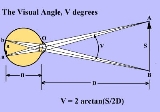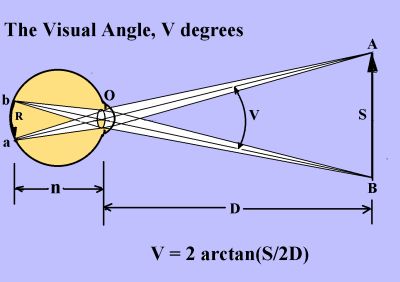
Visual angle
Encyclopedia

It also is called the object's angular size.
The diagram on the right shows an observer's eye looking at a frontal extent (the vertical arrow) that has a linear size
 , located in the distance
, located in the distance  from point
from point  .
.For present purposes, point
 can represent the eye's nodal points at about the center of the lens, and also represent the center of the eye's entrance pupil
can represent the eye's nodal points at about the center of the lens, and also represent the center of the eye's entrance pupilEntrance pupil
In an optical system, the entrance pupil is the optical image of the physical aperture stop, as 'seen' through the front of the lens system. The corresponding image of the aperture as seen through the back of the lens system is called the exit pupil...
that is only a few millimeters in front of the lens.
The three lines from object endpoint
 heading toward the eye indicate the bundle of light rays that pass through the cornea, pupil and lens to form an optical image of endpoint
heading toward the eye indicate the bundle of light rays that pass through the cornea, pupil and lens to form an optical image of endpoint  on the retina
on the retinaRetina
The vertebrate retina is a light-sensitive tissue lining the inner surface of the eye. The optics of the eye create an image of the visual world on the retina, which serves much the same function as the film in a camera. Light striking the retina initiates a cascade of chemical and electrical...
at point
 .
.The central line of the bundle represents the chief ray
Likewise for object point
 and its retinal image at
and its retinal image at  .
.The visual angle
 is the angle between the chief rays for
is the angle between the chief rays for  and
and  .
.Measuring and computing
The visual angle can be measured directly using a theodolite
can be measured directly using a theodoliteTheodolite
A theodolite is a precision instrument for measuring angles in the horizontal and vertical planes. Theodolites are mainly used for surveying applications, and have been adapted for specialized purposes in fields like metrology and rocket launch technology...
placed at point
 .
.Or, it can be calculated using the formula,
 .
.However, for visual angles smaller than about 10 degrees, this simpler formula provides very close approximations:
The retinal image and visual angle
As the above sketch shows, a real imageReal image
In optics, a real image is a representation of an object in which the perceived location is actually a point of convergence of the rays of light that make up the image. If a screen is placed in the plane of a real image the image will generally become visible on the screen...
of the object is formed on the retina between points
 and
and  . (See visual system
. (See visual systemVisual system
The visual system is the part of the central nervous system which enables organisms to process visual detail, as well as enabling several non-image forming photoresponse functions. It interprets information from visible light to build a representation of the surrounding world...
). For small angles, the size of this retinal image
 is
is
where
 is the distance from the nodal points to the retina, about 17 mm.
is the distance from the nodal points to the retina, about 17 mm.Examples
If one looks at a one-centimeter object at a distance of one meter and a two-centimeter object at a distance of two meters, both subtend the same visual angle of about 0.01 rad or 0.57°. Thus they have the same retinal image size .
.That is just a bit larger than the retinal image size for the moon, which is about
 , because, with
, because, with  , and
, and  averaging
averaging  ,
, 
 .
.Also, for some easy observations, if one holds one's index finger at arm's length, the width of the index fingernail subtends approximately one degree, and the width of the thumb at the first joint subtends approximately two degrees.
Therefore, if one is interested in the performance of the eye or the first processing steps in the visual cortex
Visual cortex
The visual cortex of the brain is the part of the cerebral cortex responsible for processing visual information. It is located in the occipital lobe, in the back of the brain....
, it does not make sense to refer to the absolute size of a viewed object (its linear size
 ). What matters is the visual angle
). What matters is the visual angle  which determines the size of the retinal image.
which determines the size of the retinal image.Terminological confusions
In astronomy the term apparent size refers to the physical angle or angular diameter
or angular diameterAngular diameter
The angular diameter or apparent size of an object as seen from a given position is the “visual diameter” of the object measured as an angle. In the vision sciences it is called the visual angle. The visual diameter is the diameter of the perspective projection of the object on a plane through its...
.
But in psychophysics
Psychophysics
Psychophysics quantitatively investigates the relationship between physical stimuli and the sensations and perceptions they effect. Psychophysics has been described as "the scientific study of the relation between stimulus and sensation" or, more completely, as "the analysis of perceptual...
and experimental psychology
Experimental psychology
Experimental psychology is a methodological approach, rather than a subject, and encompasses varied fields within psychology. Experimental psychologists have traditionally conducted research, published articles, and taught classes on neuroscience, developmental psychology, sensation, perception,...
the adjective "apparent" refers to a person's subjective experience.
So, "apparent size" has referred to how large an object looks, also often called its "perceived size".
Additional confusion has occurred because there are two qualitatively different "size" experiences for a viewed object. One is the perceived visual angle
 (or apparent visual angle) which is the subjective correlate of
(or apparent visual angle) which is the subjective correlate of  , also called the object's perceived or apparent angular size.
, also called the object's perceived or apparent angular size.The perceived visual angle is best defined as the difference between the perceived directions of the object's endpoints from oneself.
The other "size" experience is the object's perceived linear size
 (or apparent linear size) which is the subjective correlate of
(or apparent linear size) which is the subjective correlate of  , the object's physical width or height or diameter.
, the object's physical width or height or diameter.Widespread use of the ambiguous terms "apparent size" and "perceived size" without specifying the units of measure has caused confusion.
Visual angle and the visual cortex
The brain's primary visual cortex (area V1 or Brodmann area 17) contains a spatially isomorphic representation of the retina (see retinotopyRetinotopy
Retinotopy describes the spatial organization of the neuronal responses to visual stimuli. In many locations within the brain, adjacent neurons have receptive fields that include slightly different, but overlapping portions of the visual field. The position of the center of these receptive fields...
). Loosely speaking, it is a distorted "map" of the retina.
Accordingly, the size
 of a given retinal image determines the extent of the neural activity pattern eventually generated in area V1 by the associated retinal activity pattern.
of a given retinal image determines the extent of the neural activity pattern eventually generated in area V1 by the associated retinal activity pattern.Murray, Boyaci, & Kersten (2006) recently used Functional magnetic resonance imaging
Functional magnetic resonance imaging
Functional magnetic resonance imaging or functional MRI is a type of specialized MRI scan used to measure the hemodynamic response related to neural activity in the brain or spinal cord of humans or other animals. It is one of the most recently developed forms of neuroimaging...
fMRI to show, convincingly, that an increase in a viewed target's visual angle, which increases
 , increases the extent of the corresponding neural activity pattern in area V1.
, increases the extent of the corresponding neural activity pattern in area V1.Their most important finding, however, relates to the perceived visual angle
 and to the visual angle illusion.
and to the visual angle illusion.Angular size illusion and area V1
The Murray, et al. observers viewed a flat picture with two disks that subtended the same visual angle and formed retinal images of the same size
and formed retinal images of the same size  , but the perceived angular size
, but the perceived angular size  of one was about 17 % larger than for the other, due to differences in the background patterns for the disks.
of one was about 17 % larger than for the other, due to differences in the background patterns for the disks.The major discovery was that the sizes of the area V1 activity patterns related to the disks were unequal, despite the fact that the retinal images were the same size. This size difference in area V1 correlated almost perfectly with the 17 % illusory difference between the perceived visual angles.
These new findings are crucial for theories of visual space perception and especially any visual angle illusion
Visual angle illusion
In human visual perception, the visual angle, denoted θ, subtended by a viewed object sometimes looks larger or smaller than its actual value. One approach to this phenomenon posits a subjective correlate to the visual angle: the perceived visual angle or perceived angular size...
.
External links
- The University at Buffalo's Interactive Visual Acuity Chart for the display of letters or symbols for a specified Snellen line on your computer monitor at exactly the right size (note: you must follow the instructions for calibration).


